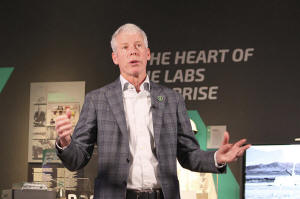US energy secretary touts nuclear power as tech sector's thirst for
electricity grows
 [February 26, 2025] By
SUSAN MONTOYA BRYAN [February 26, 2025] By
SUSAN MONTOYA BRYAN
ALBUQUERQUE, N.M. (AP) — U.S. Energy Secretary Chris Wright says it’s
critical that the nation be out in front when it comes to artificial
intelligence, and that means having reliable and affordable sources of
electricity to meet the growing demands of the technology sector.
Wright made the comments Tuesday before touring Sandia National
Laboratories. On Monday, he visited Los Alamos National Laboratory, home
to the top secret project during World War II that created the atomic
bomb.
A fossil fuel executive and graduate of MIT, Wright highlighted the
labs' legacies and said they will play a role in what he described as
this generation's Manhattan Project — a critical scientific undertaking
that will change the course of the world in ways yet to be imagined.
To win the AI race, he said the nation needs reliable and affordable
electricity and the infrastructure to move it around.
“I'm a believer,” Wright said, adding that nuclear power will be part of
the solution.
How big is the nuclear piece of the energy pie?
Federal energy analysts say the U.S. has generated more nuclear
electricity than any other country and that plants here have supplied
close to 20% of the nation's total annual electricity since 1990. That's
enough to power more than 70 million homes.

Nuclear power makes up less of the world’s portfolio when it comes to
generating energy than other sources, Wright said. That's despite plants
having small footprints and running on small amounts of material that
pack a big punch.
"It’s playing a shrinking role in our energy pot,” he said. “That
doesn’t square.”
However, many states are looking to nuclear energy to fill the gap as
more data centers come online and tech companies develop more
energy-thirsty AI tools.
Arizona already is home to one of the nation's largest nuclear plants
and utilities there have teamed up to explore the potential for building
more. Meanwhile, California extended the life of its last operating
nuclear plant with the help of more than $1 billion in federal funding.
Officials say the Diablo Canyon plant is vital to California's power
grid.
In Wyoming, TerraPower, a company started by Bill Gates, broke ground
last summer on what officials say will be one of the first advanced
reactors to operate in the U.S.
What does it take to feed nuclear power plants?
Nuclear power plants are fueled with uranium — the mining and milling of
which is a major sticking point for environmentalists who point to
legacy contamination from early operations in western U.S. states and on
Native American lands. Concerns still swirl today, with some groups
criticizing the revival of mining near the Grand Canyon.

[to top of second column] |

U.S. Energy Secretary Chris Wright talks with reporters at the
National Museum of Nuclear Science and History before a tour of
Sandia National Laboratories in Albuquerque, N.M., on Tuesday, Feb.
25, 2025. (AP Photo/Susan Montoya Bryan)
 The back end of the fuel cycle also
is an issue, with commercial reactors across the country producing
more than 2,000 metric tons of spent fuel annually, according to the
U.S. Department of Energy. Most of the waste remains at the sites
that produce it because there’s nowhere else to put it.
Private companies plan to temporarily store spent
fuel in New Mexico and West Texas. In the case of Texas, the U.S.
Supreme Court is weighing whether federal regulators have the
authority to grant licenses for such facilities to operate.
Barring a permanent solution, both Republican and Democratic leaders
in the two states have said they don't want to become the nation's
nuclear dumping ground.
Wright acknowledged the challenge of spent fuel, saying there are
“some creative ideas” on the horizon that could lead to long-term
storage solutions at multiple sites around the U.S.
Is there a clear path for more nuclear power?
U.S. President Donald Trump has set the stage, signing executive
orders aimed at stoking American innovation when it comes to AI,
declaring a national energy emergency and establishing a national
council that will be focused on “energy dominance.”
The administration also supports a multibillion-dollar venture by
OpenAI, Oracle and SoftBank that involves building data centers and
the electricity generation needed for further AI development.
The Biden administration, too, had touted nuclear power as a way to
meet demands without emitting greenhouse gases. The administration
last year set a target of at least tripling nuclear power in the
U.S. by 2050.
Standing in a corner of the national nuclear science museum in
Albuquerque, Wright noted that the nation's nuclear history began in
large part in New Mexico with the development of the atomic bomb.

There are many reasons for the lack of progress over recent decades,
including government regulations he called overly burdensome. Beyond
ensuring human safety, he said the high bars that have been set have
stifled the development of next-generation nuclear power.
“Our goal is to get that out of the way, bring private businesses
together, and figure out what kind of nudge we might need to get
shovels in the ground and next-generation small modular reactors
happening,” he said. “I think they will be part of the solution.”
All contents © copyright 2025 Associated Press. All rights reserved |